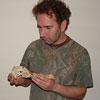Do you remember the scene in Jurassic Park where the camera pans around to take in herds of dinosaurs around a water hole? It could have been footage from a wildlife documentary about the Serengeti. The producers of that film got a lot right – even if the Velociraptors were too large, they were fast, agile and intelligent; very different from the lumbering, dim-witted giants of my childhood. The Tyrannosaurus may not have been able to chase the main characters at more than a fast walk, but who cares if that walk is almost fast enough to catch a speeding Jeep. That Tyrannosaurus was scary.
But wait! Apparently, if you didn’t move, it wouldn’t have been able to see you. That’s a bit of a let-down, almost like finding out that you can escape a Dalek by climbing a flight of stairs, or hide from an alien trophy hunter by covering yourself in mud. Did T. rex really have such a weakness?
My research explores this very subject. I am a palaeoneurologist, and I investigate the evolution of the brain and senses through fossil evidence. Our current exhibition, Tyrannosaurs, explores some of what we know about the tyrannosaur brain and senses, and I will expand on that in this, the first of two posts on the subject.

There is a lot we will never know, but in recent years we have made some major advances in our understanding of what dinosaurs and early birds might have been capable of seeing, hearing, smelling and sometimes touching. Sensory organs like eyes, ears and noses are formed from soft tissues that rot after death, so they don’t usually fossilise. The same is true of brain tissue, although the brain cavity at least often records the external shape of the brain. There are some exceptional cases of retinal cells in ancient Scottish fish eyes being preserved, but generally sensory structures don’t survive in the fossil record.
Because many of these structures were associated in life with bones, those bones sometimes record the shape of the structures they once supported. An obvious example might be something like an eye socket – the eye may not fossilise, but the socket at least indicates the maximum size of the eye ball it housed.
The optic nerve also has to pass through a hole in the bony eye socket wall to reach the brain, and the diameter of that hole can give some indication of the thickness of the original nerve bundle. This thickness relates to the number of photoreceptors (light-gathering rods and colour cones) in the retina.
Taken together, these lines of evidence might provide some clues as to whether a dinosaur was normally active in low light levels because, like an owl, we would expect a nocturnal animal’s eyes to be large in order to pack in as many light gathering rod cells. Because one nerve cell in the optic nerve can connect the visual centres in the brain with many rod cells, the optic nerve of a nocturnal eye might well be proportionately narrower than it would be if it were connected to the same large-sized eye if it were packed with cone cells.
Of course, untangling these patterns is never quite that simple!
Video above: Animation of a partial raven skull (Corvus corax) rendered from X-ray micro-CT data. As the skull fades away, a digital cast of the brain cavity is revealed (light blue).
Over the past few decades, the use of X-ray micro-CT methods has unlocked a wealth of previously hidden information about the brain and senses in extinct animals. My research relies heavily on micro-CT techniques to look inside of fossils. However, I focus on the sort of bony information that can reveal insights into sensory organs in animals that are still alive today. This information is crucial because we know what living animals do and how they behave. By concentrating on what the fossilisable bones can tell us about sensory structures that don’t fossilise in living animal species we can cross-match the same information in extinct animals.
So just how well could a Tyrannosaurus see, and how good were its other senses? Well, in this post let’s deal with vision. It’s often said that T. rex had forward-facing eyes that would have allowed it a relatively large overlap of the visual field of each eye. Large visual field overlap is needed for judging depth and distance well. This is very useful if you’re an active predator – judge the distance between you and a charging horned dinosaur wrong, and it might be the last mistake you make. T. rex was probably very good at this, better than many other theropod dinosaurs.

However, the eye sockets in T. rex actually don’t face exactly forward, and certainly not in the way cat and dog eyes do, or for that matter, the eyes of humans and other primates. In fact, even the eyes of barn owls don’t face exactly forward, even though they appear to. Does this matter?
I would argue that it doesn’t because even animals that have eyes positioned on the side of their heads, like rabbits, often have some degree of visual field overlap. Even if there is no overlap, the spot of greatest visual precision (the optic fovea) is likely to be positioned where it’s needed the most. Birds of prey may have more than one of these spots, so might T. rex also have had more than one? It’s possible, but I can’t see why such an adaptation would have been needed for a terrestrial predator. Owls, with their wide visual field overlap have only one fovea.

What T. rex did have are eyes that were positioned high enough in its head that its snout didn’t get in the way much, unlike in many other predatory theropod dinosaurs such as Allosaurus and even early tyrannosaurs. This, together with the forward angle of the eye sockets and most likely optic foveae that focused forward along the snout, would have meant T. rex would have seen you whether you stood still or put a sheet over your head!
Because no fossilised T. rex retina has been found (or probably ever will be), we will never know whether their eyes were adapted for night vision. However, the size of their eyes relative to the size of their head is more typical of an animal that is active during the day. That would suggest that their eyes would have been dominated by cone cells, so T. rex is likely to have had fairly sharp colour vision.
The eyes of birds have some notable differences to mammal eyes. For instance, like dinosaurs they have a ring of bony plates embedded in the surface of the eyeball, and the shape of the eyeball itself is not spherical. Theropod dinosaur eyes were probably fairly similar to bird eyes, which means they may well have had some of the same adaptations. Birds don’t have the trichromatic (red, blue and green) colour cone system that we have – it’s a more complex tetrachromatic system that allows them to see in light wavelengths that are invisible to us. The iridescent feathers that many birds have today must look very different to another bird because they are able to detect light in the ultraviolet range of the spectrum. The discovery of iridescent feathers in dinosaurs a few years ago means that this ability to see in ultraviolet may well have appeared in a common ancestor of T. rex and living birds. Many birds also have oil droplets in their retinas that appear to filter light in a way that may means they can perceive a wider range of hues than we can. We will never know if T. rex had this ability, but it’s certainly possible.
In the next post I will explore what we know about tyrannosaur hearing, smell, taste, balance and the sense of touch.
